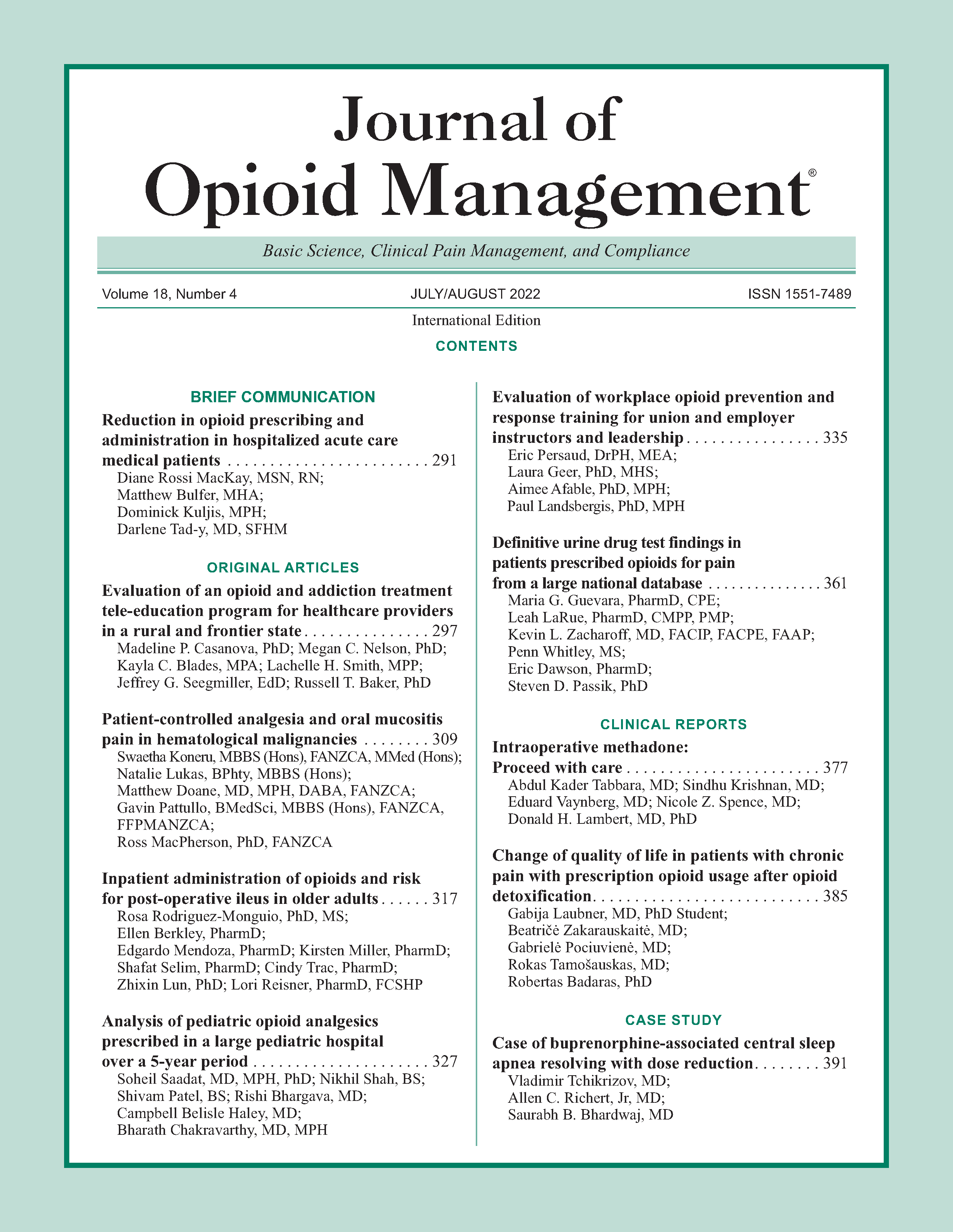Change of quality of life in patients with chronic pain with prescription opioid usage after opioid detoxification
DOI:
https://doi.org/10.5055/jom.2022.0731Keywords:
opioid, detoxification, chronic pain, quality of life, tolerance, addictionAbstract
Background: Managing patients with chronic pain with long-term opioid therapy can be challenging for the prescribers, as the development of treatment complications such as addiction and opioid-induced hyperalgesia has to be considered. There is a paucity of information on the use of opioid detoxification protocols in patients with chronic pain on a long-term opioid therapy who have developed opioid-induced complications.
Aim: To determine the effectiveness of detoxification treatment while presenting a different opioid detoxification protocol intended to cease patient's prescription opioid use while assessing patient's quality of life (QoL) changes, implicated by our treatment.
Methods: We retrospectively studied 41 patients with chronic pain with long-term prescription opioid usage who underwent elective opioid detoxification in years 2010-2019 at the Toxicology Centre of Republican Vilnius University Hospital. We ceased prescription opioids during detoxification treatment and monitored withdrawal symptoms, pain intensity, and QoL by using SF-36 scores before and right after and a minimum of 3 months after detoxification.
Results: This study was fully completed by 14 patients. At the third SF-36 evaluation, 12 out of 14 patients (85.71 percent) reported the detoxification treatment as beneficial to their overall health status compared to that before the treatment, and SF-36 scores after detoxification were significantly higher than before the treatment (p = 0.001). A decreased pain level right after detoxification was indicated by 11 patients (78.6 percent). Significant pain decrease was observed both right after and at least 3 months after the opioid detoxification treatment (p < 0.05).
Conclusions: As significant pain reduction, QoL life improvement, and opioid usage cessation were observed after opioid detoxification in the majority of patients with chronic pain, this leads us to believe that such a treatment can be safely administered and appropriated.
References
van Amsterdam J, van den Brink W: The misuse of prescription opioids: A threat for Europe? Curr Drug Abuse Rev. 2015; 8(1): 3-14.
Gomes T, Juurlink DN, Antoniou T, et al.: Gabapentin, opioids, and the risk of opioid-related death: A population-based nested case-control study. Plos Med. 2017; 14(10). DOI: 10.1371/journal.pmed.1002396.
Dowell D, Haegerich TM, Chou R: CDC guideline for prescribing opioids for chronic pain–United States, 2016. JAMA. 2016; 315(15): 1624-1645.
Eccleston C, Fisher E, Thomas KH, et al.: Interventions for the reduction of prescribed opioid use in chronic noncancer pain. Cochrane Database Syst Rev. 2017; 11(11). DOI: 10.1002/14651858.CD010323.pub3.
Shipton EA, Shipton EE, Shipton AJ: A review of the opioid epidemic: What do we do about it? Pain Ther. 2018; 7(1): 23-36. DOI: 10.1007/s40122-018-0096-7.
Murphy L, Babaei-Rad R, Buna D, et al.: Guidance on opioid tapering in the context of chronic pain: Evidence, practical advice and frequently asked questions. Can Pharm J. 2018; 151(2): 114-120.
Belkin M, Reinheimer HS, Levy J, et al.: Ameliorative response to detoxification, psychotherapy, and medical management in patients maintained on opioids for pain. Am J Addict. 2017; 26(7): 738-743.
Blum JM, Biel SS, Hilliard PE, et al.: Preoperative ultra-rapid opiate detoxification for the treatment of post-operative surgical pain. Med Hypotheses. 2015; 84(6): 529-531.
Baldini A, Von Korff M, Lin EHB: A review of potential adverse effects of long-term opioid therapy: A practitioner’s guide. Prim Care Companion CNS Disord. 2012; 14(3). DOI: 10.4088/PCC.11m01326.
NCBI Bookshelf: Do opioids induce hyperalgesia in humans? An evidence-based structured review—Database of abstracts of reviews of effects (DARE): Quality-assessed reviews. Review published 2009. Available at https://www.ncbi.nlm.nih.gov/books/NBK77651/. Accessed February 10, 2022.
Higgins C, Smith BH, Matthews K: Evidence of opioid-induced hyperalgesia in clinical populations after chronic opioid exposure: A systematic review and meta-analysis. Br J Anaesth. 2019; 122(6): e114-e126.
Vowles KE, McEntee ML, Julnes PS, et al.: Rates of opioid misuse, abuse, and addiction in chronic pain: A systematic review and data synthesis. Pain. 2015; 156(4): 569-576.
Badaras R, Jovaisa T, Lapinskiene I, et al.: Dose escalation of naltrexone to reduce stress responses associated with opioid antagonist induction: A double-blind randomized trial. J Addict Med. 2019; 14(3): 253-260.
Berna C, Kulich RJ, Rathmell JP: Tapering long-term opioid therapy in chronic noncancer pain: Evidence and recommendations for everyday practice. Mayo Clin Proc. 2015; 90(6): 828-842.
Malpus Z: Pain as a biopsychosocial experience. In Abd-Elsayed A (eds.): Pain. Springer, Cham, 2019. DOI: 10.1007/978- 3-319-99124-5_75.
Handelsman L, Cochrane KJ, Aronson MJ, et al.: (1987) Two new rating scales for opiate withdrawal. Am J Drug and Alcohol Abuse. 1987; 13(3): 293-308. DOI: 10.3109/00952998709001515.
Rugiene R, Dadoniene J, Venalis A: Comparison of health-related quality of life between patients with rheumatic diseases and a control group. Medicina (Kaunas). 2005; 41(7): 561-565.
Norkiene I, Urbanaviciute I, Kezyte G: Tomas impact of preoperative health-related quality of life on outcomes after heart surgery. ANZ J Surg. 2018; 88(4): 332-336.
Staniute M: Su sveikata susijusios gyvenimo kokybes vertinimas naudojant SF-36 klausimyna˛. Biologine˙ Psichiatrija Psichofarmakologija. 2007; 9(1): 22-25.
Nielsen S, Degenhardt L, Hoban B, et al.: A synthesis of oral morphine equivalents (OME) for opioid utilization studies. Pharmacoepidemiol Drug Saf. 2016; 25: 733-737.
Monterubbianesi MC, Capuccini J, Ferioli I: High opioid dosage rapid detoxification of cancer patient in palliative care with the Raffaeli model. J Opioid Manag. 2012; 8(5): 292-298.
Published
How to Cite
Issue
Section
License
Copyright 2005-2025, Weston Medical Publishing, LLC and Journal of Opioid Management. All Rights Reserved.











